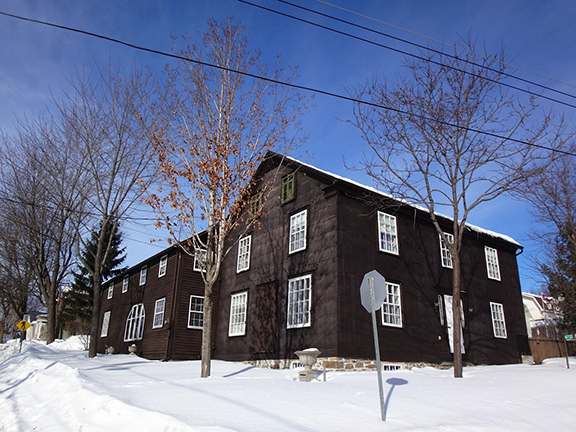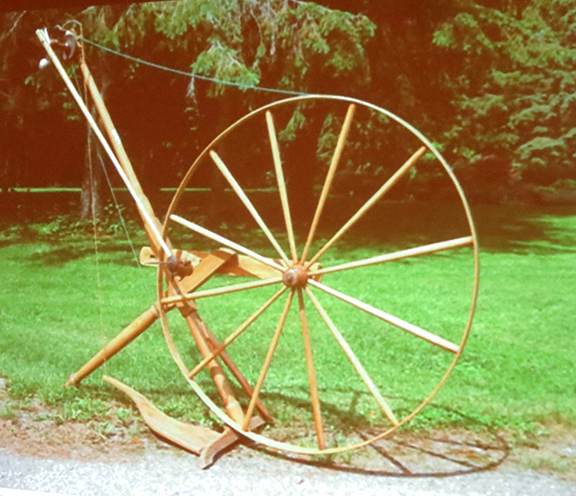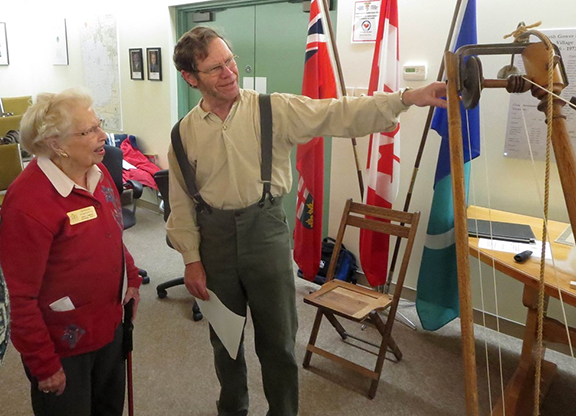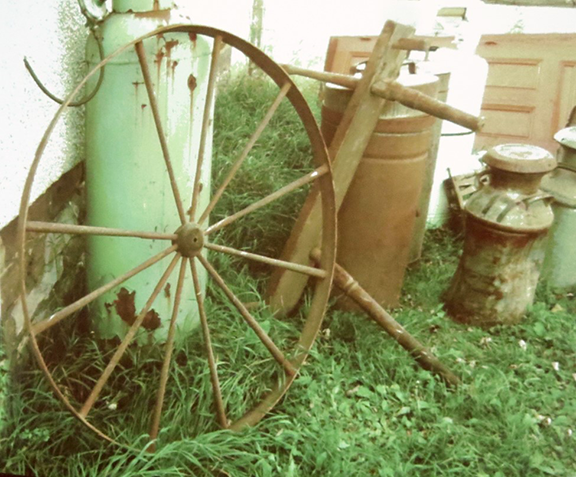Spinning Wheels and More
Presentation by Gordon Moat. Article and Pictures by Lucy Martin. March, 2015.
For our March meeting 26 members and guests gathered at the Client Services Centre on Roger Stevens Drive to hear Gordon Moat talk about spinning wheels, with a focus on what are called great wheels, for their considerable wheel size.
Prior to Moat's presentation, Susan McKellar shared slides about early Kars resident Stephen Martin, who built the spinning wheel that is on display at Dickinson House, as well as a wooden desk still used at the Rideau Archives.
Martin hailed from a large family in near-by Osgood. He bought a lot in Kars at the corner of Washington and Waterloo, very near the village wharf on the Rideau River. There he built a sizable house and attached factory in 1858. The present-day address is 6732 Waterloo St. Martin married Susannah Lindsay. (One of their daughters, Annie, went on to be mother-in-law to a RTHS founder, Coral Lindsay.) Martin bought and ran a near-by saw mill and built a grist mill. Part of 6732 Waterloo was later home to the village library for about 30 years.


After the last adult Martin child moved away the property was sold to Mr & Mrs Monkman as a summer home. Cameron and Kathryn Minor bought 6732 Waterloo in 1969 and have restored the building into very fine condition. They found a great many old tools and parts left behind, including pieces of old spinning wheels. Some may recall that Cameron Minor was an early president of the RTHS.
In introducing Gordon Moat, Brian Earl told us Moat is passionate about most everything to do with spinning and weaving - especially the “big wheels”.
Moat began by observing the meeting date was the 159 anniversary of a U.S. patent from 1856 for Lyman Wright's invention of a new type of spinning wheel he called “the Pendulum Spinner”. (You can read all about such wheels and more in the specialty publication “The Spinning Wheel Sleuth”)
Moat spent some time talking about the Stephen Martin wheel displayed at Dickinson House. That wheel is missing pieces, including its foot pedal. Moat has made pedals of the right shape for that type of wheel using elm wood from trees that had to come down on his property. He graciously donated one such pedal to Dickinson House to help restore that wheel.
The advantage of the pendulum spinner was that the space and energy needed for the older walking wheel – in which the spinner literally stood and could walk back and forth for miles while spinning - could be compressed into a smaller area and be done sitting down. Moat kindly demonstrated the different mechanisms of the walking wheel and the pendulum (sitting) wheel.
Of the two wheels Moat brought along, the pendulum wheel was purchased in good shape from a seller in Cumberland who had had it for about 20 years. The other walking wheel, presented an adventure in research and discovery. It was found, in poor condition, at a farm auction near Pierces Corners. What at first looked like a footprint mark on the inside of the wheel turned out to be a maker's stencil for “H. Row, Kemptville”.
Horton Row (b. 1832 d. 1915) was a Kemptville-area farmer and wheelwright who spent part of each year making spinning wheels. Various wheels known to be made by Row have been found and restored in this general region and it's quite likely more are still floating around, undetected. Thanks to his research, Moat could tell us that.
In 1871 one of Row's great wheels would have cost $2.50, a sum roughly equal to a half-week's wage.


In period clothing and with his restored Row great wheel, Moat sometimes gives demonstrations as “Horton Row” at Upper Canada Village and other historical events such as Kemptville's Dandelion Festival. Moat wrote in depth about Row and his great wheels for the Spinning Wheel Sleuth, issue #81, July 2013, which he shared as a handout at our meeting.
Moat's talk reminded the listeners how much has changed in terms of how we get our cloth and clothing. Speaking in generalizations, before the 1860s or so, in most Canadian households clothes, bedsheets, blankets, curtains, etc. all would have been made of “homespun” fabric. Wool or linen that was grown, harvested, spun, loomed and made by hand. Cotton cloth from the mills of England and New England was surging into that picture too. But the 100 years between 1830 and 1930 (more or less) represented a steady shift away from making fabric and clothes at home.
Even as factory goods increasingly supplanted home-made items, the marvels of mechanization also changed domestic production. This was the time period of improved spinning wheels and early sewing machines, a great boon for harried homemakers
Here I would add that spinning wheels and the process of spinning wool looks relatively simple. But the technology that went into advances like the pendulum wheel was remarkable. Consumers of those upgrades were probably as excited about greater ease and speed as we of today are about faster, smaller computers and such.
Moat stated he wasn't an especially skillful spinner since he doesn't devote enough time to actual production to be that good at it. Watching hanks of combed wool flow smoothly into spun yarn, his claim struck me as overly modest.
Audience questions were varied. There was curiosity about the types of wood used for such wheels (Row was using ash. Oak would have been common too.) Great wheels must have taken up considerable space in the home, but Moat pointed out they could be stored fairly flat along a wall when not in use.
There was some discussion about the different qualities of wool (i.e., wool off sheep bred for meat tends to be a rough fibre, merino wool was one of the better ones) which prompted a listener's comment that it's even possible to spin using dog hair.
A question came up about what source of power would have been used to make wheels of that era. Moat thinks Stephen Martin was using a steam-powered lathe in Kars. At his Kemptville workshop, Row could have been using a treadle, or a horse powered drive shaft and pulleys. Those power sources were common at that time, but it's hard to be sure what would have been used.
The audience seemed quite taken with the scope of Moat's presentation, which encompassed the tracking of historical information, what can be learned about the lives of our fore-bearers, the contrast between endless and necessary home-production of yesteryear and how easy we have it today, the amazing ingenuity of such simple-looking devices and the meticulous attention that goes into restoration work. A very interesting evening!
